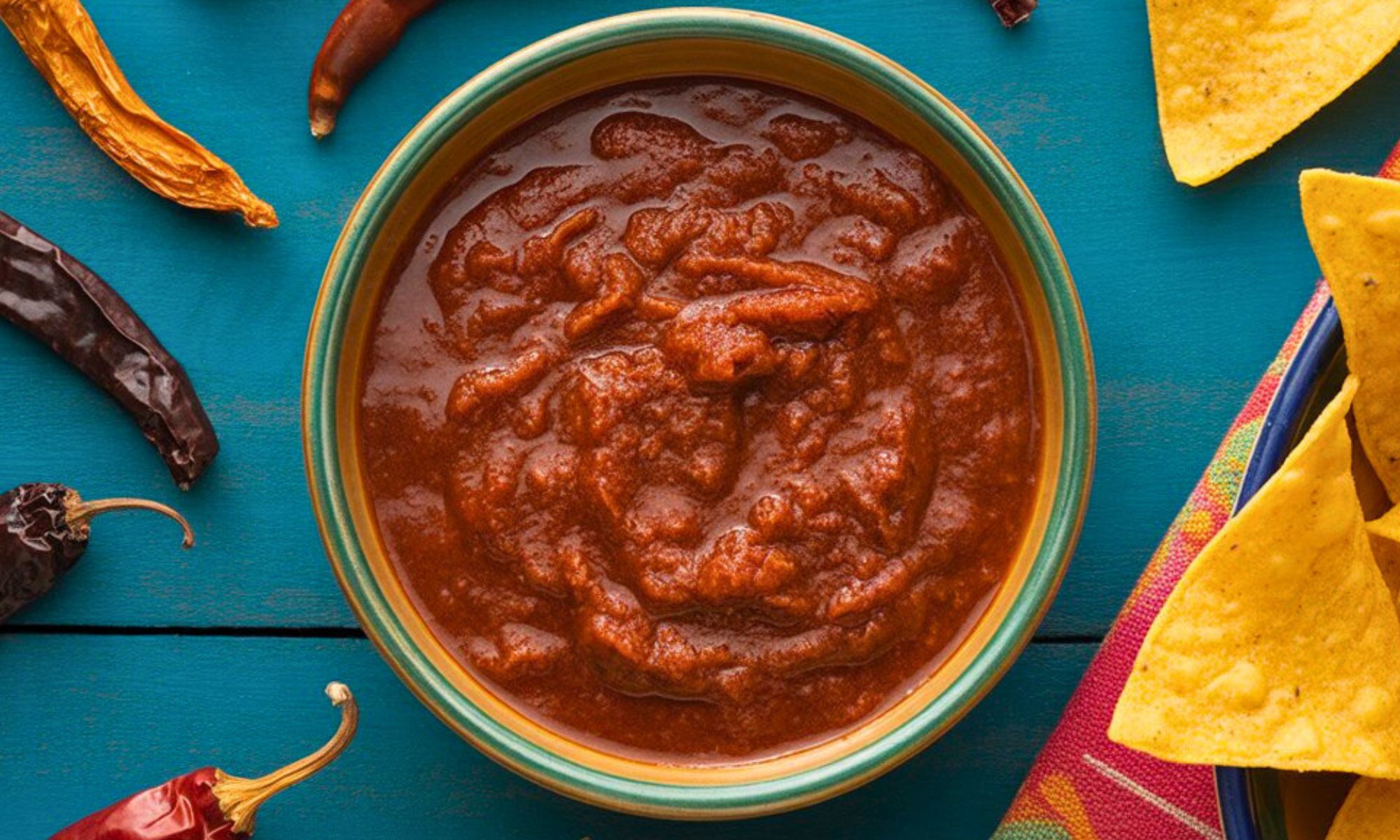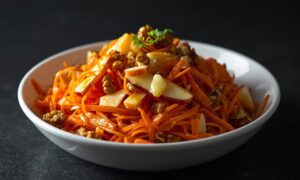That’s when I spotted a forgotten bag of dried guajillo chiles behind the rice. Not a cookbook fix, just me, a craving, and a half stocked pantry on a Thursday night. I tossed a few into a dry skillet, and as they toasted, a sweet, earthy aroma filled the kitchen, like warm spices crackling in a distant, sunlit kitchen.
Garlic sizzled in olive oil. Chiles softened in hot water. The sauce came alive, deep red, gently smoky, and just spicy enough to tingle without overwhelming. A splash of vinegar, a pinch of cumin, and suddenly I had a silky, punchy sauce that brought those tired tacos back to life.
This guajillo sauce is pure magic. Quick, budget friendly, and full of rich depth, it transforms simple food into something memorable. Drizzle it over enchiladas, swirl it into beans, or dip quesadillas straight in, once you try it, you’ll want it on everything.
Stick around, I’ll guide you through each step, share easy tips, and show you creative ways to make it your own. Trust me, after one taste… you won’t go back to store bought.
Getting to Know Your Guajillo Peppers
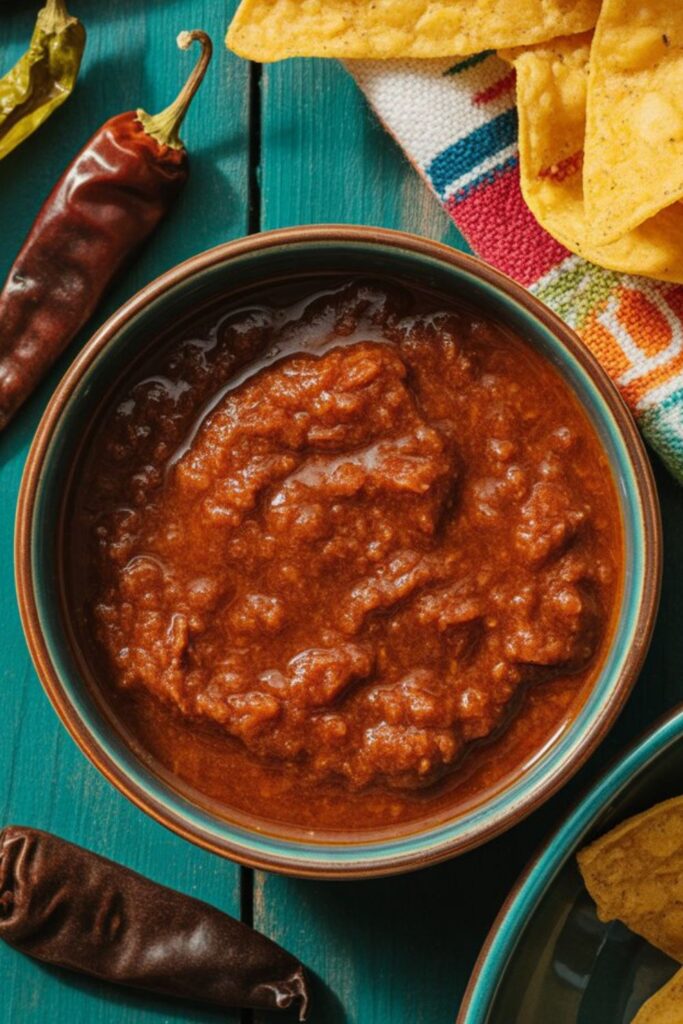
Before making sauce, choose the right peppers. Pick flexible guajillos with deep burgundy color. They should feel like soft leather. Dark, crumbly peppers lack the bright, complex flavor you want.
Here’s something most people miss: guajillo peppers contain natural sweetness that emerges with proper handling. Rush the process? You’ll get bitter disappointment instead of velvety perfection.
I find the best guajillos at Mexican markets. Don’t worry if you can’t find one nearby, online sources work great, and many regular grocery stores now stock them.
Ingredients & Smart Swaps
Gather these ingredients in cooking order:
Base ingredients:
- 8-10 dried guajillo peppers, stems removed, most seeds out
- 2 cups warm chicken broth (vegetable broth works)
- 3 garlic cloves, peeled
- 1/4 white onion, chopped roughly
- 1 tablespoon apple cider vinegar
- 1 teaspoon salt (adjust to taste)
- 1/2 teaspoon ground cumin
- 1/4 teaspoon Mexican oregano
Optional flavor boosters:
- 1 tablespoon tomato paste (adds richness)
- 1 teaspoon brown sugar (if peppers taste tannic)
- 1 chipotle pepper in adobo (for smokiness)
Let’s talk smart swaps. No chicken broth? Water works fine, though you’ll lose some depth. Can’t find Mexican oregano? Use half the amount of regular oregano, it’s stronger.
Here’s my secret: if your guajillos seem past their prime, add that tomato paste. It smooths harsh edges and creates gorgeous, glossy finish.
For vinegar, I prefer apple cider, but white vinegar or lime juice works. Acid brightens flavors and preserves your sauce.
The Magic Behind Guajillo Sauce – Step by Step
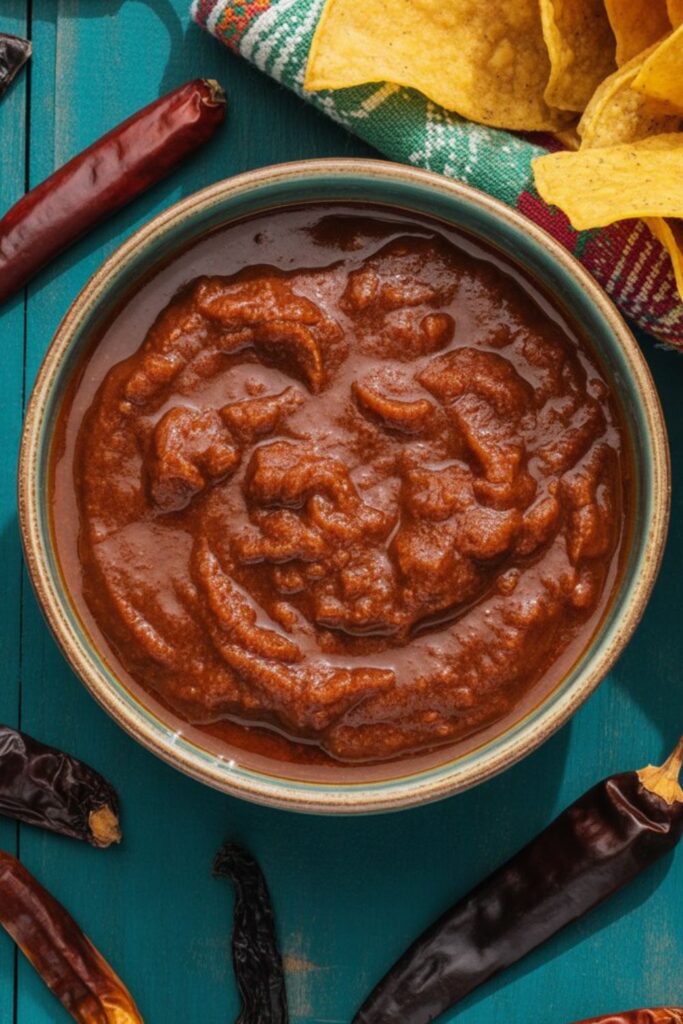
Step 1: Wake Up Those Peppers
Remove stems from your guajillos. Don’t fuss over every seed, a few add character. Heat a dry skillet over medium and toast peppers 30 seconds per side. You’ll smell when they’re ready, that toasty aroma that transforms your kitchen.
Here’s where people mess up: over toasting. See black spots or smell bitterness? You’ve gone too far. Peppers should just warm and release oils.
Step 2: The Soaking Game
Drop toasted peppers into a bowl and cover with warm broth. Let them soak 20-30 minutes. They’ll soften and plump like flavor sponges.
While they soak, prep other ingredients. Peel garlic, chop onion, measure spices.
Step 3: Build the Flavor Base
Use the same skillet from toasting (don’t wash it, those pepper oils are gold). Sauté onion and garlic until fragrant and golden, about 5 minutes.
Step 4: The Magic Blend
Now everything comes together. Drain peppers but save that soaking liquid, it’s precious. Toss peppers, sautéed onion and garlic, cumin, oregano, salt, and vinegar into your blender. Add 1 cup soaking liquid.
Here’s the crucial part: blend aggressively for 2-3 minutes. You want silk smoothness. Add more soaking liquid to reach your desired consistency.
Step 5: The Final Touch
Strain your sauce through fine mesh sieve. This step separates pros from amateurs. Press mixture through sieve to remove stubborn pepper skins and achieve restaurant quality smoothness.
Taste and adjust. More salt? Add it. Want tang? Splash vinegar. Too thick? Thin with broth or water.
The Science Behind the Magic
Making guajillo sauce isn’t just cooking, it’s chemistry in action. Dried peppers lock in intense flavor compounds, and rehydrating them brings those taste packed oils and acids back to life.
Toasting activates the Maillard reaction, where natural sugars and amino acids create complex, nutty, smoky notes, similar to roasting coffee or browning butter.
Extended blending breaks down stubborn cell walls, delivering that signature velvety finish that clings beautifully to food.
Vinegar pulls double duty: it brightens the overall flavor while acting as a natural preservative. This acidic touch not only balances heat and smokiness but also extends the shelf life, keeping your sauce fresh for weeks..
Making It Beautiful & Delicious
Perfect guajillo sauce shows deep burgundy color. It should coat a spoon but pour smoothly. Get it right, and you’ll have glossy finish that photographs beautifully.
For plating, less beats more. Strategic drizzles or small pools look more elegant than drowning everything in sauce.
This sauce rocks with:
- Grilled chicken or pork (incredible as marinade)
- Roasted vegetables, especially sweet potatoes
- Scrambled eggs for morning kick
- Pozole or other Mexican soups
- Quesadillas or tacos
For wine, choose medium bodied reds. The sauce’s earthiness pairs perfectly with Tempranillo or Garnacha.
The Perfect Guajillo Sauce Finish
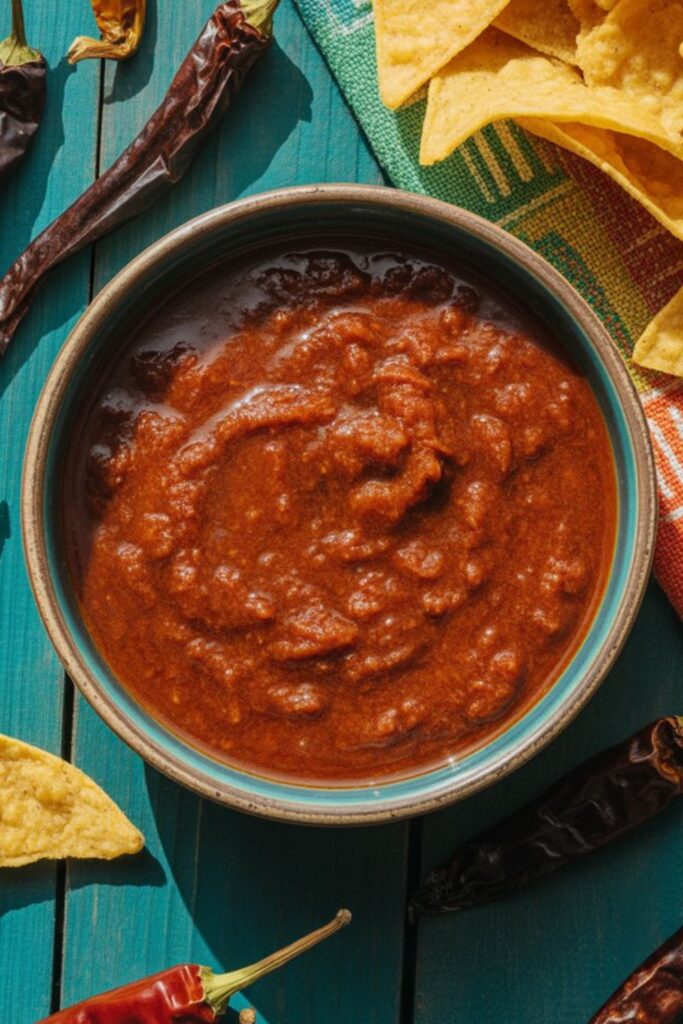
Guajillo sauce is more than just a recipe, It’s your secret weapon in the kitchen. One spoonful can transform a plain taco into something unforgettable. It wakes up rice, adds a smoky hug to grilled meats, and brings warmth to everyday meals. Once you make it right, there’s no turning back.
The magic begins with patience. Soak the dried guajillo peppers until they’re soft and pliable. No shortcuts here, softness unlocks their rich color and deep flavor. Then blend them until smooth, adding just enough liquid to keep things moving. Strain the sauce well to remove bits and seeds. That one extra step makes all the difference between good and unforgettable.
Store your finished sauce in a sealed jar and refrigerate for up to two weeks. The flavor matures beautifully with time. For long term use, freeze it in ice cube trays and pop the cubes into freezer bags. They thaw quickly and make flavor packed additions to soups, stews, rice bowls, or beans.
Want a pro tip? Always double the recipe. Once your family gets a taste, they’ll want it on everything, eggs, roasted veggies, burgers, enchiladas, even pizza. I’ve even stirred it into mac and cheese for a smoky twist!
Guajillo sauce isn’t just about taste. It’s about comfort, character, and tradition. It brings people together around the table. It’s bold, ruby red, and rich with flavor. Once it’s part of your kitchen, you’ll wonder how you ever cooked without it.
Frequently Asked Questions about Guajillo Sauce
Can I make Guajillo Sauce without a high powered blender?
Yes! You can still make Guajillo Sauce with a regular blender, just blend longer and add a bit more liquid to help it along. Pause often to scrape the sides and keep things moving. Since standard blenders leave more texture, be sure to strain the sauce well for a smooth finish.
Don’t worry if it’s not silky at first, patience and a sieve will get you there. It’s worth the extra step for that velvety texture.
How spicy is Guajillo Sauce?
Guajillo peppers offer mild heat, about 3 out of 10. They’re much milder than jalapeños, making this sauce more flavorful than fiery. Craving more heat? Toss in a dried árbol or chipotle pepper for an extra kick.
This balance makes it a crowd pleaser, kid friendly yet still bold enough for spice lovers.
Why does my Guajillo Sauce taste bitter?
Bitterness usually comes from over toasting or using old peppers. Toast peppers only until fragrant, about 30 seconds per side. If the sauce is already bitter, a touch of brown sugar, honey, or even orange juice can help balance it out.
Always use fresh, pliable dried peppers. If they snap or crack, they’re past their prime.
Can I use fresh guajillo peppers instead of dried?
Fresh guajillo peppers aren’t available, as they’re the dried version of mirasol chilies. While you can use fresh mirasol peppers, the recipe will need adjustments. Dried Guajillo offer a deep, concentrated flavor that fresh chilies can’t match.
Drying intensifies the color, flavor, and aroma that signature red hue? It comes from the drying magic.
How long does homemade Guajillo Sauce last?
Stored in an airtight container in the fridge, Guajillo Sauce stays fresh for up to 2 weeks. For longer storage, freeze in ice cube trays, then move the cubes to freezer bags. Frozen sauce lasts up to 6 months and reheats easily.
It’s a flavor booster ready anytime, Just melt a cube into soups, tacos, or stews for instant depth.
Final Thoughts on Guajillo Sauce
In the world of bold flavors and comforting traditions, Guajillo Sauce stands out as a kitchen essential that balances heat, smokiness, and rich character in every spoonful. It’s more than just a sauce. It’s a connection to heritage, a boost for everyday meals, and a flavor enhancer that never goes unnoticed.
Whether you’re a seasoned cook or just discovering the magic of dried chilies, mastering Guajillo Sauce brings confidence and creativity to your cooking. From tacos and beans to soups and grilled meats, it has the power to turn simple food into something memorable.
Keep a jar in your fridge, a stash in your freezer, and you’ll always be just one spoonful away from something special.

Swiftly Captions by Tina Smith — Quick, flavorful food recipes made simple, bringing fresh inspiration to your kitchen every day
